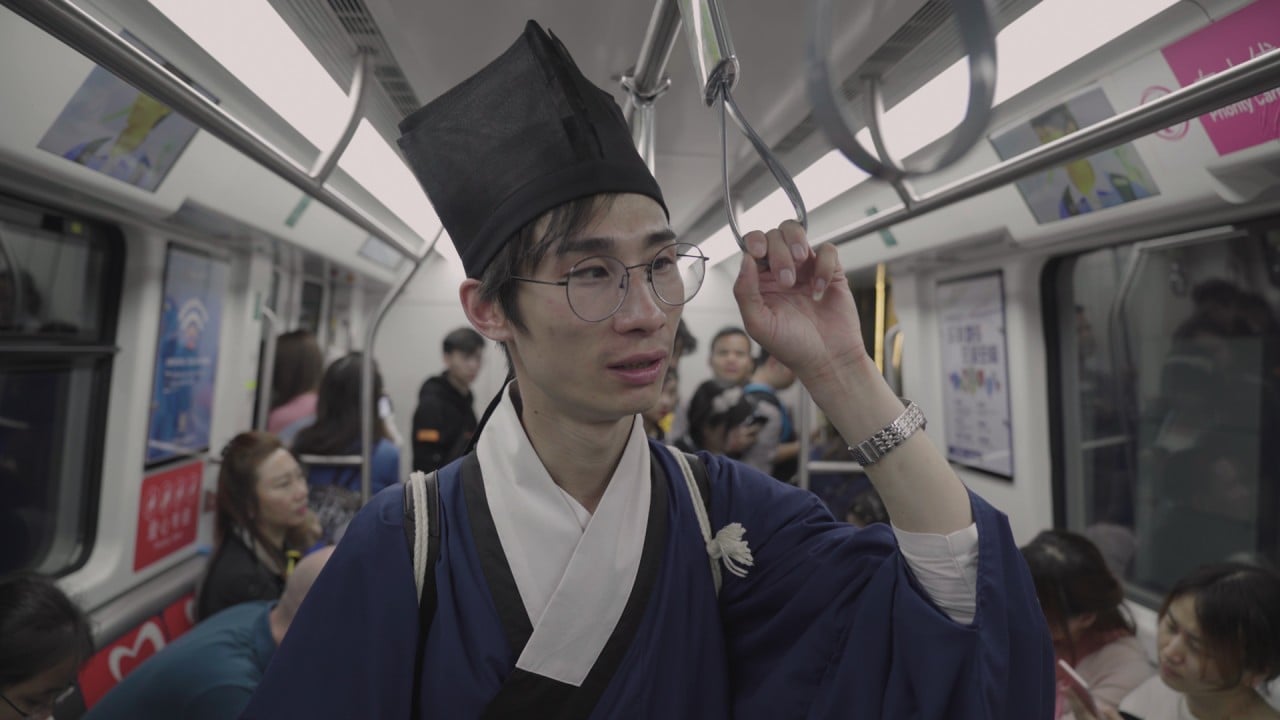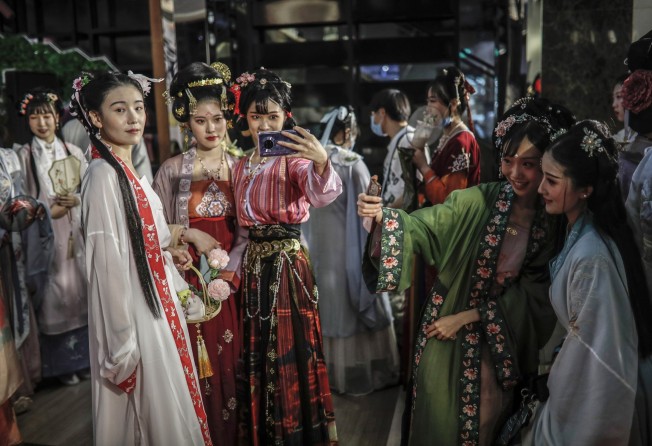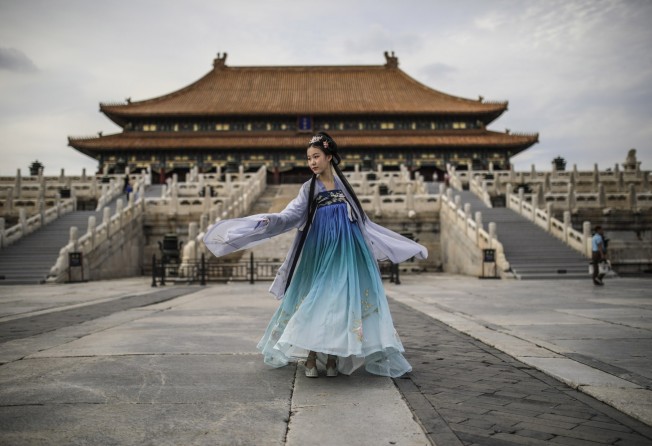
06:21
Young people in China are reviving old clothing, and maybe nationalism too

Wang Shuxin is one of many young Chinese seeking to revive traditional aesthetics and reflect their patriotism through their shopping choices.
The 20-year-old will mix a Tang-period-style embroidered top with jeans when attending university lectures, don a Ming-period-style dress when hanging out with friends on weekends, and regularly shares her shopping tips and purchases of Hanfu – outfits inspired by the ensembles worn by ancient Han Chinese – on social media.
“I love traditional Chinese culture and want to do my part in promoting it,” she said.
Like many Chinese born between the mid-1990s and 2010, Wang is digitally savvy, has known only a rising China – making her much more culturally confident than previous generations – and is willing to spend money on domestic brands. Members of what is known as Generation Z, they are among the highest spenders in the country and are set to become a key driver of domestic consumption.
It was such young, nationalistic Chinese who drove the backlash against Western brands like H&M and Nike last year after the companies denounced the alleged use of forced labour in cotton production in the Xinjiang Uygur autonomous region. They were again at the forefront in July as French luxury brand Dior was accused of cultural appropriation for allegedly copying the design of a traditional Chinese “horse-face skirt”.
In the eyes of young Chinese shoppers, the “made in China” label is no longer synonymous with poor quality. It has, instead, created a consumer trend called Guochao, or “China-chic”, that has spawned home-grown brands that integrate Chinese cultural elements and traditional motifs into their products’ marketing campaigns.
The trend also includes young people who buy local brands as a show of patriotism. They are swapping Estée Lauder lipsticks for those produced by Chinese brands like Perfect Diary or Florasis, and sip cheese-topped Chinese tea from Hey Tea rather than Starbucks coffee. Chinese fragrance brand To Summer’s position as the creator of “Eastern scent” has set itself apart from Western fragrance makers like Diptyque or Jo Malone.
Their shifting preferences are reshaping China’s consumer sector. As Western brands’ influence wanes, local brands have been gaining ground.
The trend, which started around 2018, also coincided with growing tensions between China and the United States and its Western allies, marked by a protracted trade war and the detention in Canada of Meng Wanzhou, an executive of Chinese tech giant Huawei Technologies, that led to a wave of nationalistic sentiment.

“Unlike previous generations, the post-2000 generation did not experience the years when China was still a poor country flooded with fake and low-quality products,” said Li Yingtao, a senior analyst for retail business at Beijing-based market research firm Analysys. “They have only experienced a rising China.
“Amid the turbulence in international relations, the young people today no longer favour only Western brands like those who were born in the 1970s or 80s. They are more confident about their country and have stronger trust in local brands.”
The trend has accelerated since the start of the Covid-19 pandemic as China has turned inward and pushed for economic and technological self-reliance, creating new opportunities for Chinese brands.
Anta Sports, a local rival of Nike and Adidas, recently reported that it had surpassed its Western competitors in revenue in the Chinese market in the first two quarters of this year.
A survey of Chinese consumers this year by consultancy PwC found that 45 per cent of respondents said they would buy a Chinese brand over a foreign brand, up 10 percentage points compared with last year.
Domestic brands accounted for 45 per cent of sales during the Singles’ Day online shopping festival last year, up 17 percentage points from the previous year.
Shi San Yu, a rising local fashion brand that mainly sells Hanfu, was quick to capitalise on the recent backlash against Dior, rolling out a campaign that promoted its version of the horse-face skirt, or mamianqun, on Chinese social media platforms. Industry insiders said factory orders for the brand’s mamianqun had surged in recent months.
“Mamianqun does not truly belong to us until we wear it,” the brand’s founder, Lian Yuxin, said in a promotional video.
Once a niche hobby, Hanfu has grown increasingly popular among young Chinese in recent years, emerging as a billion-dollar industry.
Last year, the Hanfu market grew 6.4 per cent year on year to 10.1 billion yuan (US$1.4 billion), according to a recent report published by Shi San Yu in association with the China National Garment Association, Tmall Clothing, and iResearch Consulting Group.

An office worker in Nanjing, the capital of Jiangsu province, who spends an average of 100,000 yuan on Hanfu each year, said that when she first became interested in such clothing, nobody paid attention to it.
“Now it has become a lot more mainstream and people recognise it’s part of our cultural heritage,” she said.
Over the past decade, she has seen Hanfu emerge from being an obscure subculture and handmade craft to mass-produced goods appealing to a growing crowd, and she rents out her Hanfu collection to museums and television production teams.
But she said most Chinese brands still lacked the international prestige and influence that major Western brands enjoyed.
“In the olden days, goods coming from China used to be synonymous with luxury in the eyes of European aristocrats,” she said. “But now many Chinese people would still think it’s cool to carry a bag printed with English or French words. Our domestic brands still lack the influence on a global level.”
The revival of consumer interest in Chinese culture is in step with President Xi Jinping’s vision of promoting the country’s “cultural confidence” and soft power to match China’s economic and geopolitical rise.
Becoming a “cultural power” is part of Xi’s plan to grow China’s per capita GDP into that of a “medium-level developed country” by 2035. That pledge was reiterated in the report he delivered at the Communist Party’s five-yearly national congress last month.
Over the past few years, the number of television shows on traditional Chinese culture produced by national and provincial broadcasters has increased significantly. The shows have been immensely popular and have often become trending topics on social media.
The Palace Museum in Beijing has attracted younger Chinese in recent years with merchandise that puts a creative spin on traditional cultural elements as well as its collaboration with national broadcaster China Central Television in creating documentaries on cultural preservation. The museum was so successful in reinventing its image that it became a branding case study after its former director and curator Shan Jixiang announced it had earned 1.5 billion yuan in 2017.

“The emergence of Guochao is the result of the combining forces of the market and state support,” said Zhang Peng, an associate professor specialising in cultural studies at Nanjing Normal University.
“The popularity of cultural heritage sites and TV shows on related themes have led to a revival of Chinese culture in recent years. Many companies have taken advantage of the trend as they seek to upgrade themselves from being mere manufacturers to high-end brands.”
While state support has created more fertile ground for the growth of domestic brands, local players are also better positioned due to their understanding of the Chinese market and their familiarity with Chinese social media platforms, industry insiders and analysts said.
“There have been a lot more new competitors coming into the market in recent years, so it was crucial for us to stay on top of the latest trends with better designs and better marketing strategies,” said the founder of Hanfu brand City of Morning Dew, who asked to be identified as Wang.
Li said home-grown brands were more nimble in responding to the uncertainties in the Chinese market as prolonged lockdowns and strict Covid restrictions limited foreign brands’ access to China.
Earlier this year, Spanish retail giant Inditex closed the e-commerce operations and physical stores of its three high-street brands, Bershka, Pull & Bear and Stradivarius, in China.
“With locally based senior managers and factories, Chinese brands are able to make and execute key decisions more quickly than their overseas competitors,” Li said.
But with the era of rapid economic growth over, the youth unemployment rate rising, and a drop in consumer confidence in recent months, how long Chinese brands could maintain their growth remained unclear.
“Guochao has created great opportunities for local brands,” he said. “But companies should not rely solely on growth brought by the trend and focus on building a sustainable business.”
Local brands needed to boost their overall operational capabilities and improve their designs as they sought to become premium or luxury labels, Li added.
“The luxury sector is still an area in which most Chinese brands lag far behind their Western competitors,” he said. “It takes time and sustained efforts to build a luxury label. You can’t win with only marketing strategies or production speed.”
Zhang also said Chinese firms should take the long view.
“Some companies see Guochao only as an opportunity to make quick cash,” he said. “But Guochao shouldn’t only be a selling point. Chinese brands should constantly innovate and aspire to become the torch-bearer of Chinese culture.”